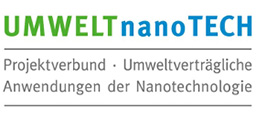UMWELTnanoTECH
ENVIRONMENTALLY COMPATIBLE APPLICATIONS OF NANOTECHNOLOGY

4 Hybrid capacitors for smart grids and regenerative energy technologies
Field of work:
Energy Storage DevicesThe generation of power with regenerative energy technologies, such as wind and solar, is dependent on weather conditions which change with the seasons, e. g. sunshine hours or average wind speed. Currently there is no suitable and reliable energy storage system available for the short-term by-passing of resulting power fluctuations. New reserve systems should compensate for consumption peaks in power production and also avoid temporary mains loads or overloads. Efficient and customized energy storage devices are also of great interest in other areas, such as electromobility or the energy supply for smartphones and laptops with ever increasing capacity demands.
The goal of the current project is to develop hybrid capacitors into high-efficiency energy storage devices with enhanced application suitability. Like electrochemical double-layer capacitors, hybrid capacitors store energy through the formation of an electrochemical double layer. But additional energy can be stored by incorporating lithium ions in an active material in the same way as it is done in lithium ion batteries. The combination of these two storage mechanisms should enable systems with a higher and more customized energy and power density. The beneficial properties of capacitors in terms of service life, efficiency and reliability are to be preserved in the process.
At the start of this project, the carbon batch was switched from Kuraray YP-17D (batch from preliminary work no longer commercially available) to Kuraray YP-50F. Here, differences were determined in combustion temperatures and residues as well as in the BET surface.
Previously, the active carbon Kuraray YP-50F was used with Li4Ti5O12- and LiFePO4-Sol. As a result, nanoscale particle mixtures were created from a converted active carbon and the active battery material which remain to be studied and electrochemically characterized.
Furthermore, eight different commercial separators are tested regarding their suitability for use in hybrid capacitors. The difference between the separators is relatively small in terms of their electrochemical properties and is within the range of measurement error for the cells used. For additional electrochemical tests, a separator was selected due to its small thickness (25 μm).
Next, different commercial active carbon materials are to be coated with battery materials and tested in terms of their suitability as active materials in hybrid-capacitors.
As a new synthesis tool, a microwave-based process is being examined in order to deposit battery materials on activated carbon with shorter reaction times in a certain quality which has not yet been achieved. In addition, it is also possible to modify the manufacturing conditions by chemically or thermally activating the active carbon before the conversion.



